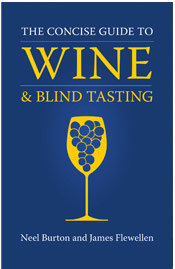The concise guide to wine and blind tasting
| Title of book: | The concise guide to wine and blind tasting |
| Author: | Neel Burton and James Flewellen |
| Publisher: | Acheron Press |
| Publication date: | 2014 |
| ISBN | 978 0 9560353 9 4 |
| Pages: | 376 |
| Price: | £25.00 |
 These guys are academics of non-vinous subjects with, it seems, a veritable clutch of post-nominals between them. It appears the blind winetasting bit of their lives is all just for fun. How great is that. And whilst their book provides admirable, and indeed concise, introductions to the wine regions of the world, it is the section on the blind tasting guide that really piqued my interest.
These guys are academics of non-vinous subjects with, it seems, a veritable clutch of post-nominals between them. It appears the blind winetasting bit of their lives is all just for fun. How great is that. And whilst their book provides admirable, and indeed concise, introductions to the wine regions of the world, it is the section on the blind tasting guide that really piqued my interest.
For good measure they also outline the basics of viticulture and vinification, which provides some important clues of how climatic parameters and/or winemaking decisions may influence flavours in the glass.
The blind tasting guide comprises just 6% of this volume. I like the idea that wine parameters may be divined rather than analysed and interpreted by an inspired taster; I wonder how many of us add in this element to our own deductions and judgements!
We are introduced to the elements in wine that we can taste or sense: alcohol; acids; sugars; polyphenols; aromas. And then to the five senses of taste, to which are added tactile sensations offering information on such things as body, texture, temperature, carbon dioxide. All of which the brain must interpret, trying to eliminate bias, pre-conception and emotion along the way. The authors list these items succinctly and logically.
There is more detail on definitions of horizontal and vertical blind tastings, part-seen tastings where you might know all the wines are from a single region or from a single grape variety, for example; on glassware; temperature as well as thoughts on tasting order. On the point of temperature, if I were running a blind tasting, I might serve everything at room temperature, otherwise knowledge of recommended serving temperatures might funnel one’s deductions to particular places and styles. Added to which colder temperatures seem to reduce aromas.
The authors give a good top line summary of typical wines according, variously, to colour, primary aroma, use, or not, of new oak, lees and bottle age. They add in clues from acidity style and quantity, plus tannin style and quantity.
After the blind tasting section, most of the book is reserved for a review of wine-growing regions around the world, often with a brief section on wine style, some with useful introductory comparisons of style to other locations. The idea is if you bank all the evidential knowledge of wine styles from around the world e.g. very modest alcohol plus high acidity plus acute, fresh primary aromas may lead one to consider Mosel riesling or e.g. medium high alcohol plus nutty, mealy citrus fruit, plus subtly integrated richness of new oak may lead one to consider something white from the Côte d’Or, the process of deduction and elimination is greatly simplified.
There is nothing new or ground-breaking in this book (I don’t think it sets out with such objectives), but it is a readily accessible summary of stuff that you might otherwise have to source from a few different places.



